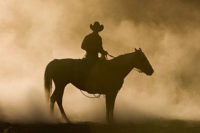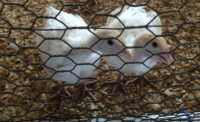Farm to Plate: Don’t get burned!
To have your animals ready to face the inevitable summer heat, you need to make preparations now.

The summer of 2012 was difficult, to say the least, for the entire food animal supply chain. Drought conditions from the southwestern United States through the heart of the Corn Belt left little grass to graze or grain to harvest. As the threat of reduced feed availability set in, many farmers and ranchers were left with no choice other than to sell their stock.
This year, we hope more moisture will show up in the forecast on a consistent basis to thwart a second year of deep culling from our herds.
Although we cannot control the weather, we can make preparations now for the heat that is sure to arrive as summer sets in. There are some basic preparations that can be made to reduce the impact of heat on animals that are in transit or waiting at the slaughter facility.
Set a schedule
If your live-animal procurement department doesn’t typically rely on an unloading schedule, this is an important step to take before the summer heat sets in. By giving livestock transporters a designated unloading time with a 15- to 30-minute unloading window, it is easier to plan how animals will flow through your facility throughout the day. You can count on getting the animals off the truck as soon as possible if you know when trucks are expected to arrive. Prompt unloading is a critical step in maximizing the survival rate of animals in transit.
Load and transport early in the morning
Placing animals in transit well before sunrise ensures that transportation is happening during the coolest part of the day. Although the early-morning or late-night loading schedule may be tiring for the people at the farm level, they are improving their chances of animals arriving at the plant in better condition than they would by the time the temperature peaks in the mid-afternoon. On top of that, early-morning loading might allow the transporter to miss rush-hour traffic if the haul is timed appropriately.
Keep the trucks moving
One of the most important things to remember regarding the transport of livestock in hot temperatures is the role that truck and trailer movement plays in cooling the inside of livestock trailers. If it is not possible to unload the trailer, and the unloading appointment has to be delayed, the live-animal procurement office should instruct the transporter to enter a “holding pattern” instead of parking. This will help to keep the temperatures inside the trailer tolerable for the livestock.
Have a plan for trucks that are waiting to unload
Once a load of animals enters your premise or enters a line of additional transporters waiting to unload that is near your facility, your plant is legally responsible for the welfare of the animals on those trucks. In the summer, you will need to have a plan for the trucks that are waiting to unload. Some facilities have water hoses available that can be hooked to misting equipment on specially equipped trailers. Others have built large banks of fans that a transporter can pull up to and force cooler air into the trailer. However, not all solutions need a large investment in capital — a good scheduling program is one of the best options, and it doesn’t have to cost anything. Just keep in mind — if you don’t have a plan for keeping the temperatures under control on the trucks that are waiting at your facility, you could be asking for trouble.
Provide access to clean water
Water is one of the first things many animals will look for upon arrival at the plant after transportation in elevated temperatures. It is important to make sure that enough water is available for as many of the animals as reasonably possible. It may be difficult to be certain of the last time an animal on a newly arrived load had a chance to drink, so you must be ready. Not only is the provision of clean water the right thing to do, it is required by the Humane Methods of Slaughter Act and 9 CFR 313.
Pay attention to air movement
Once the animals are in your facility, do you have adequate air flow to prevent heat buildup if you have indoor holding pens? A slight rise in heat load in the barn is expected with the radiant heat from the sun shining on the roof and the body heat of the animals accumulating under the roof. It is important to make sure that any roof vents that were closed during the winter months are opened before the temperature starts to rise. In addition, positive pressure must be maintained on the slaughter floor to help keep flies and dust at bay. This will introduce additional heat to the barn, which must be appropriately vented as well. A steady exchange of outside air through the barn will help to keep the temperature and flies under control.
Monitor compromised stock
Animals that display compromised health upon arrival at your plant should be closely monitored, because they will have a greater difficulty in coping with heat stress. The Humane Methods of Slaughter Act and 9 CFR 313 require animals that are classified as USDA Suspect receive protection from extreme environmental conditions. This means they must be under some sort of roof. During periods of excessive heat, these animals should be monitored more often to ensure their well-being. Sprinklers, misters, or light spray from a water hose may be useful to keep them cooled down. If the excessive heat exacerbates an animal’s health condition to the extent that their survival is unlikely but they are still eligible for slaughter, their movement to the stunning operation should be expedited to prevent prolonged suffering. If they are condemned during antemortem inspection, they should be humanely euthanized right away.
Have a plan for redirecting in-transit livestock if a plant breakdown occurs.
Excessive heat doesn’t just put additional strain on people and animals. Equipment breakdowns can halt production and present a whole new set of challenges from a logistical standpoint. It is best to be prepared for such an event. Make sure you have arrangements in place to redirect loads of livestock that are en route to your plant. Local livestock markets and stockyards are good options. If you have space to hold animals over in your facility, remember to provide clean water at all times. You are required to provide feed if they are held for more than 24 hours. The two most important things to remember if your facility experiences a breakdown are: (1) have a plan in place to deal with inbound animals and (2) communicate! communicate! communicate!
Well before the summer heat sets in, it is best to have a clear plan for dealing with the challenges that your facility may face. It is fair to say that an hour or two of proactive planning and preparation could save a lot of animals and prevent days of crisis management.
Looking for a reprint of this article?
From high-res PDFs to custom plaques, order your copy today!






